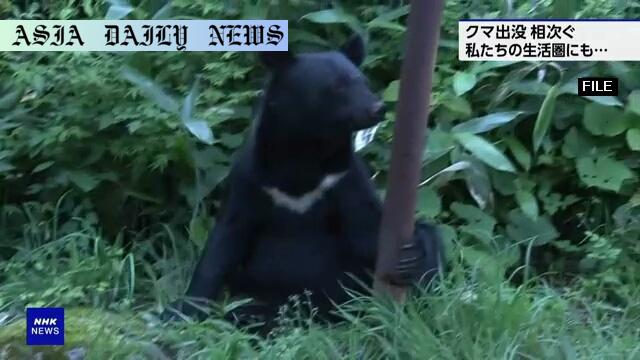Bear Attacks: Wild bears continue to encroach into human-occupied areas in Japan, leaving two people injured on Monday in separate attacks.

Bear Encounters on the Rise in Japan
Japan is grappling with an alarming increase in wild bear encounters in human-populated areas. This growing issue has led to not only property damage but also recent physical harm to residents. On Monday alone, two individuals sustained injuries in separate bear attacks, underlining the urgency of implementing safety measures and awareness. Authorities across the nation are now on high alert, urging citizens to be vigilant while calls for interventions to manage bear populations intensify.
The Incidents: Unfolding Danger Close to Home
In Tochigi Prefecture’s Nasushiobara City, a dramatic event unfolded involving a man in his 70s. Police reported receiving an alarming call at 6:30 a.m. about a bear on the loose in the area. They found the injured man with neck and head wounds at a nearby home, where he had sought safety. While the victim’s injuries were not life-threatening, the event sparked widespread concern, especially since it occurred only 500 meters from an elementary school. Eyewitnesses estimate the bear was about 1.5 meters tall, making it a potential danger to both adults and children in the community.
Earlier at 4:40 a.m. on the same day, an 81-year-old man in Morioka City, Iwate Prefecture, encountered a bear while weeding outside a junior high school. The bear inflicted injuries on the man’s head, but like in the Tochigi case, prompt medical intervention ensured he could recover. Both incidents have rattled these communities, illustrating the immediacy of the issue at hand.
Schools and Residential Safety Concerns
Educational institutions in affected areas are stepping up measures to ensure student safety. In Aibetsu Town, Hokkaido, junior high school officials discovered fresh bear footprints in their schoolyard, prompting the cancellation of outdoor classes. Students were sent home in organized groups to minimize risks. Such incidents raise valid concerns about the encroachment of wildlife into spaces where children and families reside. While schools and homeowners attempt to balance daily routines and safety, bear incursions continue to disrupt their sense of normalcy.
Exploring Causes Behind the Surge
The upward trend in bear-human encounters can be attributed to both environmental and ecological factors. Urban expansion and deforestation have significantly encroached on the natural habitats of wild bears, pushing them toward inhabited areas in search of food. Additionally, climate change has altered seasonal food availability for bears, restricting their access to traditional sustenance sources like nuts and fruits in the wild. Consequently, hungry bears venture closer to human establishments, heightening chances for potentially dangerous encounters.
Steps Toward Safety and Coexistence
While bear attacks evoke anxiety, experts suggest practical measures to mitigate risks. Educational programs that teach residents how to handle bear sightings and avoid provocation can reduce accidental situations. Municipalities are also employing strategies like bear traps, warning signage, and monitoring of wildlife patterns to safeguard communities. With proper collaboration between authorities, conservationists, and citizens, there’s hope for maintaining a harmonious coexistence between humans and wildlife in Japan.
The government must prioritize long-term solutions, combining habitat restoration projects with community awareness campaigns. Balancing safety measures and ecological responsibility will be crucial in addressing the bear-related challenges plaguing Japan’s urban and rural regions alike.
Commentary
The Growing Concern of Bear-Human Encounters
The rise in bear attacks and human encounters is becoming a critical issue in Japan, reflecting the broader challenge of wildlife conservation and urbanization. These incidents call for reflection, not only about the immediate safety of residents but also on how human activity has disrupted natural ecosystems. The occurrence of two separate attacks on the same day illustrates just how pressing this issue has become.
Human Responsibility Amid Bear Attacks
While it’s easy to place blame entirely on the bears, it’s important to consider that human expansion into forested areas has disrupted the delicate balance of nature. With their habitats increasingly diminished, bears have little choice but to venture into populated areas in search of food. This situation speaks volumes about the unintended consequences of urban sprawl and deforestation, which have long been overlooked in favor of economic development.
Balancing Coexistence and Safety
The stories of survival and resilience from the two injured men are a testament to the importance of preparedness and swift response in such situations. However, it also underscores a significant gap in proactive safety measures in areas susceptible to wildlife encounters. Residents should not live in fear but must be equipped with tools and knowledge to handle such incidents. Collaborative efforts among the government, local authorities, and communities can pave the way toward safer coexistence between humans and bears.
Ultimately, this issue requires a multifaceted approach—one that involves protecting people while also addressing the root causes that lead to such encounters. Education, awareness, and sustainable environmental policies can make a difference in ensuring that stories like these are no longer commonplace.


